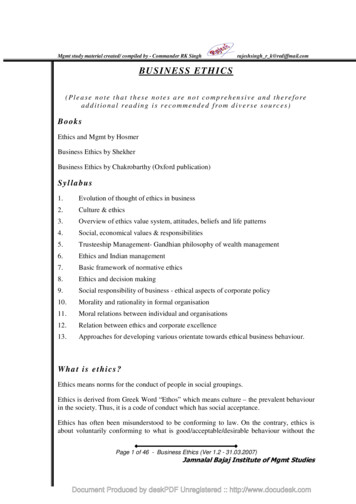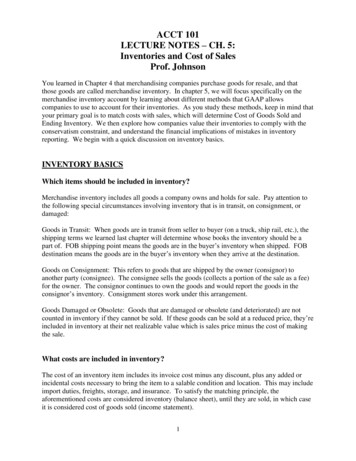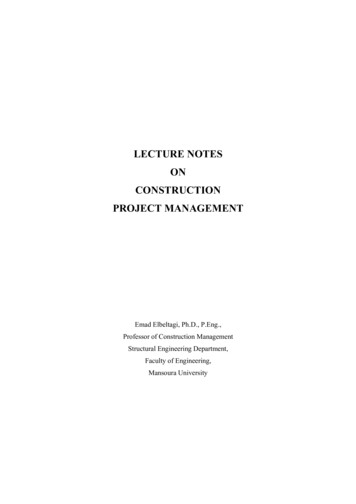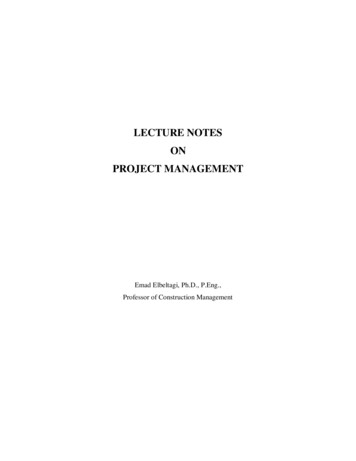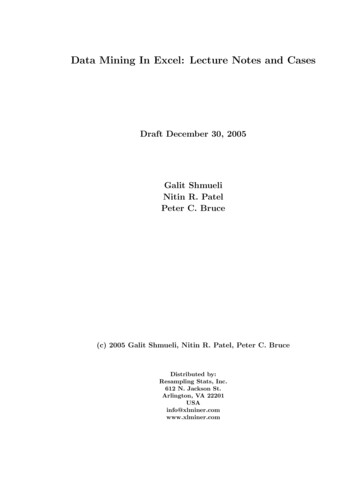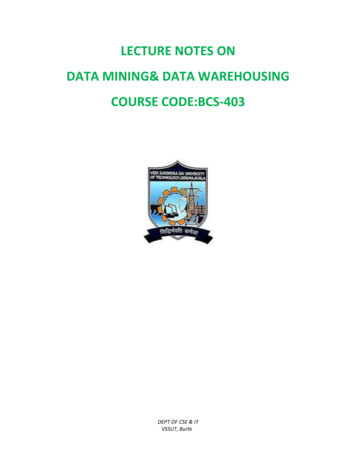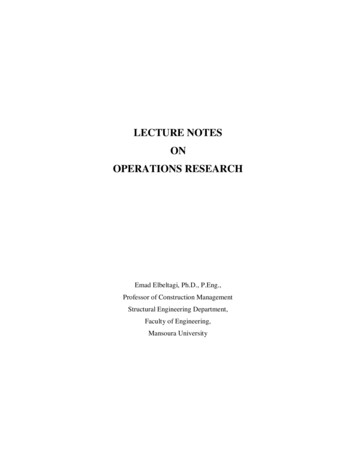
Transcription
LECTURE NOTESONOPERATIONS RESEARCHEmad Elbeltagi, Ph.D., P.Eng.,Professor of Construction ManagementStructural Engineering Department,Faculty of Engineering,Mansoura University
Operations Research2013Copyright 2009 by the author. All rights reserved. No part of this book may bereproduced or distributed in any form or by any means, or stored in a data base orretrieval system, without the prior written permissions of the author.
PREFACEIn the Name of ALLAH the Most Merciful, the Most CompassionateAll praise is due to ALLAH and blessings and peace be upon His messenger and servant,Muhammad, and upon his family and companions and whoever follows his guidanceuntil the Day of Resurrection.Operations research is a relatively young field, having emerged during the middledecades of the twentieth century. However, its impact has been quite remarkable. It hasbecome a standard tool for improving the efficiency of business operations around theworld. This book deals with some tools of a larger field called operations research.This book is dedicated mainly to undergraduate engineering students, especially CivilEngineering students where most of the applications are presented in the civil engineeringfield. It provides the reader with the main knowledge to model a given system usinglinear programming and solving such linear model. It includes five chapters: Chapter 1provides a general introduction to types of models and the main steps of modeling asystem. Chapter 2 introduces the principles of mathematical modeling using linearprogramming and the graphical solution to solve the model. The simplex method forsolving linear programming models is presented in chapter 3. Chapter 4 is dedicated formodeling and solving the transportation and assignment problems. Finally, chapter 5 isdealing with the decision analysis techniques. Many solved examples have been added toenable the students to understand the material presented in this book. Also, each chapteris followed by exercises for training purposes.Finally, May ALLAH accepts this humble work and I hope it will be beneficial to itsreaders.i
TABLE OF CONTENTSCHAPTER 1: INTRODUCTION1.1 The origin of the Operations Research science11.2 Overview of System Analysis Modeling Approach11.3 Types of Models41.3.1 Descriptive versus Prescriptive41.3.2 Deterministic versus Stochastic51.3.3 Statistical Models51.4 Rules for Modeling61.5 Sample Modeling61.5.1 Sample Model 161.5.2 Sample Model 271.6 Exercises8CHAPTER 2: MODELING WITH LINEAR PROGRAMMING2.1 Main Assumptions for Linear Programming122.2 Inequalities versus Equations122.2.1 Equations122.2.2 Inequalities132.2.3 Graphical Representation of Inequalities132.3 Linear Programming: An Introductory Example142.3.1 Modeling152.3.2 Standard Form of Linear Programming162.3.3 Solving the Model Graphically172.3.4 Terminology of the Model Solution202.3.5 Solving Using Solver Program222.4 Second Example: Market Allocations252.4.1 Modeling252.4.2 Solving the Model Graphically262.4.3 Solving Using Solver Program27ii
2.5 Types of Linear Programming Solutions282.5.1 Problems Having Unique Optima292.5.2 Problems Having Alternate Optima292.5.3 Problems Having No Feasible Solution312.5.4 Problems that are Unbounded312.6 Limitations of Linear Programming Modeling322.7 Linear Programming Models332.7.1 Diet Problem332.7.2 Workforce Planning352.7.3 Financial Portfolio362.8 Solved Examples372.8.1 Example 1372.8.2 Example 2382.8.3 Example 3392.8.4 Example 4402.8.5 Example 5422.8.5 Example 6432.9 Exercises44CHAPTER 3: THE SIMPLEX METHOD3.1 Gauss-Jordan Elimination for Solving Linear Equations513.2 The Essence of the Simplex Method543.3 Setting up the Simplex Method563.4 Solution of Linear Programs by the Simplex Method583.5 The Simplex Method in Tabular Format643.6 Special Cases663.6.1 Tie for Entering Non-Basic Variables663.6.2 Alternate Optimal Solutions673.6.3 Degeneracy683.6.4 Unbounded Optimum (No leaving basic variable)703.6.5 Infeasible Solution71iii
3.6.6 Equality Constraints723.6.7 The Inequality Constraints753.6.8 Negative Right-hand Sides753.6.9 Minimized Objective763.7 Sensitivity Analysis783.7.1 Right-hand Side Sensitivity793.7.2 Objective Function Sensitivity803.8 Solved Examples813.8.1 Example 1813.8.2 Example 2823.8.3 Example 3833.8.4 Example 4843.9 Exercises85CHAPTER 4: THE TRANSPORTATION AND ASSIGNMENT PROBLEMS4.1 The Transportation Problem914.1.1 The Transportation Problem Model944.1.2 The Simplex Method for the Transportation Problem102Solving the Transportation Problem Using Vogel’sApproximation Method1044.2 The Assignment Problem1144.2.1 The Assignment Problem Model1154.2.2 Solving the Transportation Problem Using Vogel’sApproximation Method1194.3 Solved Examples1204.3.1 Example 11204.3.2 Example 21224.3.3 Example 31244.4 Exercises125iv
CHAPTER 5: DECISION ANALYSIS5.1 Prototype Example1295.2 General Representation1305.3 Decisions under Uncertainty1315.3.1 The Max-Min Payoff Criterion1315.3.2 The Maximum Likelihood Criterion1325.3.3 The Expected Return1325.4 Decision Trees1365.5 Sensitivity Analysis1395.6 Sequential Decisions1405.6.1 Conditional Probability1405.3.2 Decisions under Conditional Probability1415.7 Solved Examples1475.7.1 Example 11475.7.2 Example 21485.7.3 Example 31495.7.4 Example 41515.8 Exercises152REFERENCES156v
CHAPTER 1INTRODUCTION1.1. The Origin of the Operations Research ScienceAfter the industrial revolution and change in organization size and complexity, itbecomes more and more difficult to allocate and utilize resources efficiently. However,this science became more advanced since the Second World War as there was an urgentneed to allocate the scarce resources to the various military operations. Another factorthat added greatly to this science is the computer revolution.As it is seen from the name of the course “system analysis” or “analysis of the systems”,so it is related to how to conduct and coordinate operations within a system ororganization. It can be applied to many areas such as, financial planning, health care,military, public services, construction, etc.System analysis “operation research” frequently attempts to find a best solution – calledthe optimum solution - for a given problem.1.2. Overview of System Analysis Modeling Approach1. Define the problem and gather relevant dataMostly, when a practical problem described, it is described in a vague andimprecise way. Therefore, the first order is to develop a well-definedstatement of the problem, i.e., determining such things as the appropriateobjectives, constraints, inter-relationships, possible alternative courses ofaction, time limits for making a decision, etc. It is difficult to extract a rightanswer from the wrong defined problem.Operations Research1Dr. Emad Elbeltagi
It is necessary to seek solutions that are optimal for all variables (the wholeorganization) rather than suboptimal solutions that are best for only onecomponent. The problem of privatizing the water network of a city generallyaffects four parties: the owner who desires profit; the employees who desiresteady employment; the people who desire low priced and high quality water;the government which desire a continuous services and fair taxes.2. Formulate a mathematical model to represent the problemAfter defining the problem, the next phase is to reformulate this problem in aform that is suitable for analysis. Models or idealized representation can beused to express any daily life action such as the motion of a car, chemicalreactions, etc. For example, the famous law F ma, is a sample ofmathematical model. So, mathematical model is the system of equations thatdescribe the problem. For example, if there some factors that affect theprofitability of an organization (such as number of products, price, productiontime, etc.) and they need to be determined. These factors are called thedecision variables and can be denoted mathematically as x1, x2, . xn. If theprofit is measured in terms of these variables as p ax1 bx2 . cxn,this is called the objective function. Any restrictions that may be applied tothese variables can be also represented mathematically and called constraints.These constraints can be represented in terms of inequalities or equations suchas, x1 0, and dx2 –x3 k, etc.The mathematical model, in this case is to choose the values for the decisionvariables so as to maximize the objective function and respect the givenconstraints. One of the most used mathematical models is the linearprogramming models, where the mathematical functions appear in both theobjective function and the constraints are all linear functions.Operations Research2Dr. Emad Elbeltagi
Mathematical models are very essential and have many advantages oververbal description of the problem, as they describe the problem more preciselyand accordingly make the problem more comprehensible. It allows the use ofcomputers to analyze the problem.Sometimes, it is necessary to do some simplifying assumptions to make theproblem solvable. Therefore, care must be taken to ensure that the modelremains a valid representation of the problem.For instance, consider the problem of the construction site layout planning.This problem is described verbally as: it is required to layout the temporaryfacilities on a construction site so as to increase safety, visibility, and toreduce traveling time within the site.3. Develop a procedure for driving solutions to the problemThe next step after mathematical formulation for a given problem is todevelop a procedure for solving the problem. For instance, this procedure maybe a computer program. Sometimes, software shells might be used for solvingmathematical models. It is necessary, that the procedure being able to searchfor an optimal, or best, solution.Sometimes, obtaining an optimal solution for a problem becomes verydifficult and time consuming and may be even impossible. In such case,heuristic procedures may be used. Heuristic procedures are rule-basedmethods that seek good or sub-optimal solutions.4. Test the model and refine it as neededThe procedure used to solve the model need to be tested to make sure that theprocedure is error-free. The model can be tested against benchmark problemsin the same area that is developed for. This process of testing the model isusually called model validation.Operations Research3Dr. Emad Elbeltagi
5. Prepare for the application of the modelAfter the testing of the model has been completed and an acceptable modelhas been developed, the next step is to install a well-documented system forapplying the model. These documents include the model, solution procedure,and operating procedures for implementation.6. ImplementationThe last step is to implement the system. This is the most important stepbecause it ensures that the model is translated into an operating procedure.1.3. Types of Models1.3.1 Descriptive versus PrescriptiveModels are always built to assist in the design or management of natural orconstructed process. Many people refer to these models as Mathematical Models.For the most part, models from various disciplines were built using differential anddifference equations to explain, to comprehend, and to predict natural phenomena.These mathematical representations are called descriptive models because theyoffer, for a given set of inputs and initial conditions, a description of the outputsthrough time the phenomena under study. Descriptive models is said to answer thequestion, “If I follow this course of action, what will happen?” The descriptivemodel predicts the quantitative outcomes possibly through time.Prescriptive models, on the other hand, focuses on the science of decision makingand policy development. The invention of a mathematics of decision making alongwith the continual improvement of digital computers make it possible for thedevelopment of more powerful and complicated models. The representation thatuses the mathematics of decision making is called a prescriptive model because itprescribes a course of action, a design, or a policy. Prescriptive models is said toanswer the question, “What is the best course of action that I might follow?” TheOperations Research4Dr. Emad Elbeltagi
prescriptive model finds and suggests the best strategy to choose from all possiblestrategies. Another term used for a prescriptive model is to call it an optimizationmodel. The material presented in these notes will focus on prescriptive models.1.3.2 Deterministic versus StochasticIn deterministic models, parameter values are determined and known at the outset.Models of this type are characterized by their data elements are not thought of asvariable but as relatively fixed and predictable quantities. For example, given theinitial contents of the stockpile and a specified release of materials and a statedpurchase or manufacture of new materials during a unit of time, a deterministicmodel suggests that there is just one possibility for the final end-of-period conditionof the stockpile. That is, only a single outcome can occur from a month’s eventsgiven a specific choice of action.In contrast to deterministic models, other models might utilize data elements thatare not precisely known but can be characterized by a mean and some randomvariation about the mean. For example, predicting the flow in a reservoir during aspecific month may not be accurately defined as in some years the flow may byhigh and on other years it may be low. Models in which the data elements arerandom or variable (i.e., capable of taking on any value from a range of values) arecalled stochastic models. Given an initial value of the storage in the reservoir, and aknown amount of release for water supply, the stochastic model suggests that theend-of-month contents of the reservoir can be stated, but with some uncertainty.This is because of the random inflow to the reservoir.1.3.3 Statistical ModelsPositioned in concept somewhere between the deterministic and
Operations research is a relatively young field, having emerged during the middle decades of the twentieth century. However, its impact has been quite remarkable. It has become a standard tool for improving the efficiency of business operations around the world. This book deals with some tools of a larger field called operations research.




